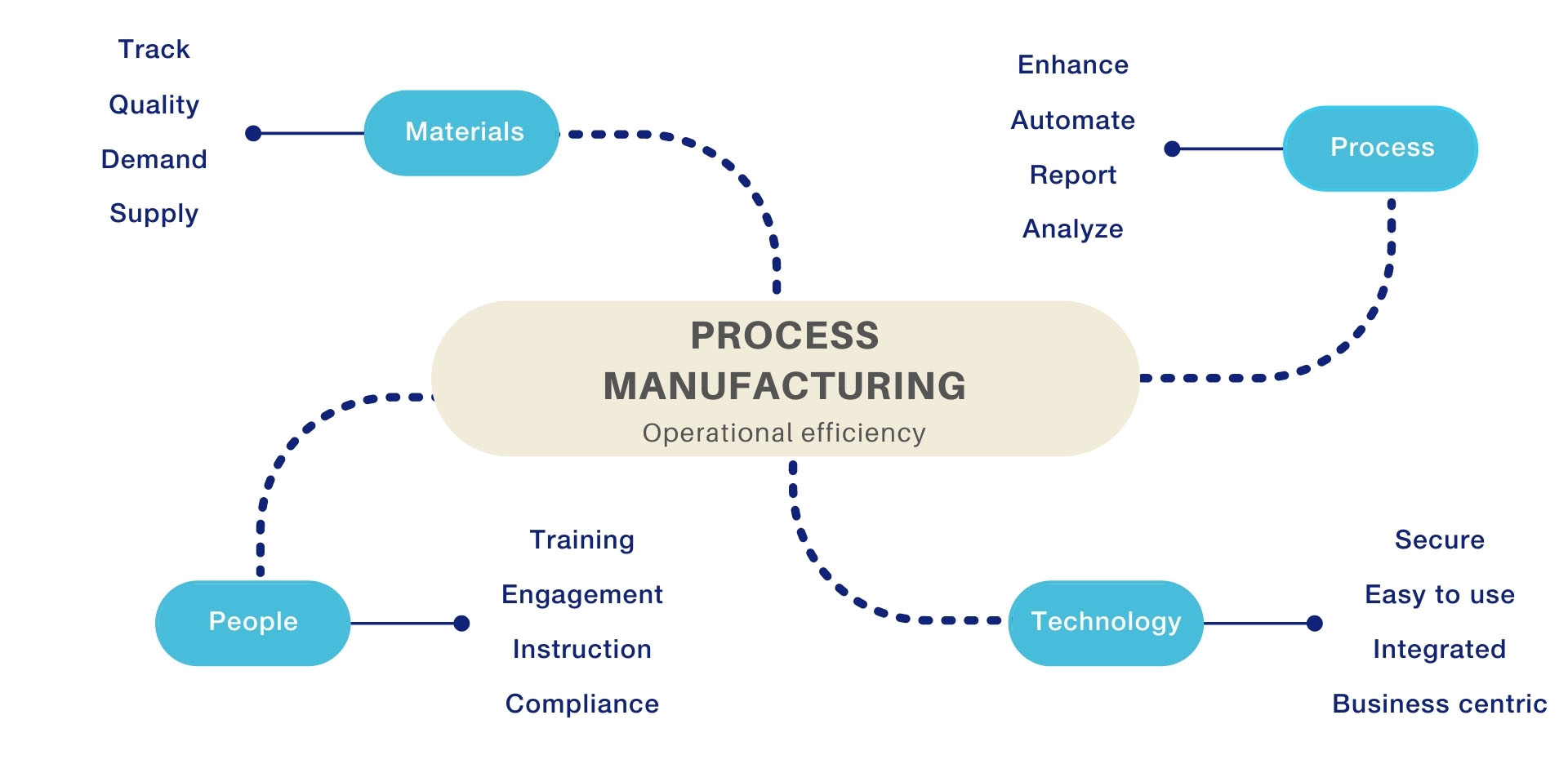Introduction
The COVID-19 pandemic has created significant changes in market dynamics, forever changing the face of the global economy. Along with the pandemic’s impact on our daily lives, there has been a ripple effect in the day-to-day operations of Pharmaceutical manufacturing. As industries around the world continue to adjust to changes, Pharmaceutical manufacturers in specific, are noticing technology, process, and infrastructure gaps that are impeding growth and sustainability. Additionally, businesses that were forced to slowdown production during the initial stages of COVID-19 and are now getting back to full momentum, are finding it difficult to manage end-to-end operations.
Pharmaceutical companies cater to a customer base that is dependent on their products to manage patient health. This requires additional efficiency in everything they do, especially for planning supply-demand. The primary objective is to not halt manufacturing, as the dependencies can impact the entire Pharma value chain. Since pharma companies are quality controlled, there is an additional time factor that comes into the picture while determining the right deadlines to produce finished product and deliver to end customers. The entire process from drug discovery to packaging for delivery is a series of collaborations within the supply chain before the final product reaches the end customer.
Roughly 66% of the surveyed were concerned that COVID-19 could result in a possible supply chain disruption for pharmaceutical products. The statistic illustrates concern levels on possible drug supply chain disruptions due to the COVID-19 pandemic as of April 7, 2020.
The Planner’s Panorama
Due to the rapid changes in the global supply chains, production planners at pharmaceutical manufacturing are now tasked with surveying inventory and operations with a new set of eyes. Organizations need to be more watchful of new safety standards related to inventory storage, retrieval, usage of material, and equipment maintenance. Tools like Visual Gantt Charts are becoming invaluable for planning and managing inventory. The ability to depict a weekly schedule of operations for different production jobs and a clear picture of resource capacity is a core requirement for any good production planner. The production planner’s prime focus is to ensure there are enough raw materials and resources (equipment or human resources) to ensure a near-to-perfect supply-demand ratio. An additional element that supports a planner is to have inventory visibility within their current warehouse and plan transfers of inventory from overflow warehouses.

Simple visual planning methods are no longer adequate to correctly manage all inventory-supply-demand processes and ensure proper movement of transactions across the company’s supply chain.
What planners need is a robust system that can track supply – demand by including a complex set of parameters such as lead times, working calendars, the capacity of equipment and capability of vendors to ship materials on a timely manner. Planners also need the ability to alert different departments of the next steps based on plans made for upcoming weeks or months. Any modern system should be able to offer required insights including the current state of batches manufactured and available equipment for future work orders.
A production planner often prefers handling the supply chain proactively rather than reactively by responding to the demands. The planner needs visibility of when the finished product will be ready, tested, and released for shipment. This type of planning helps overcome downtime and shortages in raw materials, which is a common issue in most companies. Responding quickly to changing inventory is one way for planners to be more proactive.

Even today, many small and medium-sized pharmaceutical companies continue to use a combination of excel sheets, inventory reports, and some old school methods when managing their supply chain. As industries continue to face changes related to the COVID-19 pandemic, only companies that have thought ahead and have invested in an automated AI-based planning system that can assess and predict future demand as well projected resource plans will be best equipped to handle their product delivery on time and in full. Companies now need a quicker and more streamlined process to take their products to market.
The Role of a Master Planning and Scheduling System
01. MPS Driven by Demand
The goal of a Master Planning and Scheduling (MPS) system is to provide suggestions to meet material requirements. If set up correctly, MPS systems respond to demand and plan supply accordingly. Demand usually comes from sales orders recorded in the Order Management system. Master planning ties Planned orders for Production or Procurement to corresponding sales orders. The supply requirements are then calculated based on settings for each item that is included in the Finished Goods Bill Of Material(BOM). The coverage settings of an item show precisely how and when to send feedback with a view of current stock levels or foreseen changes in stock levels from existing planned orders in place.
02. Planned Supply
MPS systems use algorithms for tracking the demand from sales orders, customer forecasts, safety stock levels, and calculating net-requirements for purchase and manufacturing. MPS also pulls together independent or groups of demands that trace back to the production of intermediate and raw materials to be consumed in different Manufacturing and Packout processes.
Determining the quantities required would depend on the inventory quantity setup of any single item. The requirement could be specific for a static batch size or dynamic quantities based on the demand needs. MPS systems provide planners the capability to either consolidate supplies across multiple demand orders, offering a comprehensive supply and demand management experience, or consider only the net change from the start of a full production run.
03. Lead Times
The ability to define lead times is critical to a master scheduling system. For instance, if a user enters a purchase lead time the system should account for the time it takes to receive raw materials after placing a purchase order.
I. Purchase Lead Times
Purchase lead times for a supplier can be set up based on different factors including
- Pricing agreements
- Time in days that a supplier can accommodate
- Transportation time, and
- Any other unforeseen coverage settings
Within Dynamics 365 Finance and Supply Chain, a purchase lead time found for a specific supplier and item combinations takes precedence over general settings of an item. This applies when (1) no vendor is assigned to the item, and (2) the Find trade agreements checkbox is selected via Master planning parameters form > Planned orders tab.
II. Production Lead Times
Production lead times are the details that can be configured in coverage settings; however, these values are disregarded when items are produced via routes. Routes, defined in the modern Production control modules, consider available resources (people or equipment) and their working schedule. In this situation, production lead times needed to create finished goods do not have to be specified by a user, as they are calculated automatically.
Planning for the Unknown
There are still unknowns within pharmaceutical production and operations. Without the right system, planners will struggle to retrieve the data needed to better streamline the manufacturing process. To help with this, Production Planners can benefit from valuable information like –
- Batch production history and patterns of user behavior that show actual production lead times
- Quality standards of work-in-process production run based on raw materials that are procured from specific suppliers
- Quantity yields of past batches, actual scrap percentages based on changes in production routes and resources
- Accurate actual batch costings in comparison with estimates
These additional details provide supplementary insights to help improve production, downtime planning, maintenance, and most importantly, promise dates to customers. Production planners need to be equipped with a system that presents elaborate sets of insights and actionable suggestions on how to plan/schedule production operations. A well reliable tool empowers a company to drive efficiency and growth.
An AI-ML & Analytics Centric Approach
Eventually, and soon, a standard planning system will no longer be capable for the Pharmaceutical supply chain to operate efficiently. Systems that reduce human effort, learn from history, and improve daily operations will become necessary to overcome inefficiencies. At the same time reporting possible issues and roadblocks that impact orders as well as deliveries, improves the overall plan vs actual picture. Production planners are proving to be more efficient when they have real-time and historical analytics available during the planning process to make better decisions while managing inventory and orders. A guided method of operating and reporting through actionable data can make your company a powerhouse within the industry. An intelligent and optimized planning system can help eliminate guesswork for the production planners in build a competitive edge in the market.
Final Thoughts
The supply chain within a pharmaceutical company is only as efficient as the ability of a planner to proactively coordinate supply, demand, and inventory. A robust planning system with an emphasis on analytics and guided user behavior can play a key role in building efficiency and moving shipments out the door, along with meeting the required quality standards.
Xcelpros has designed Microsoft’s offerings to enhance planning for Pharmaceutical, Chemical, or Biotech industries. For more information on Production planning and Scheduling tools within Microsoft – Schedule Demo







